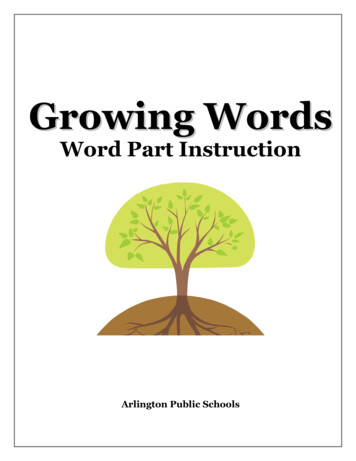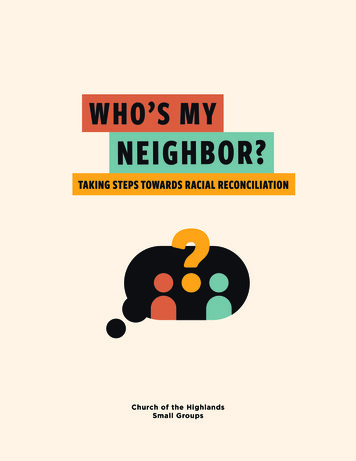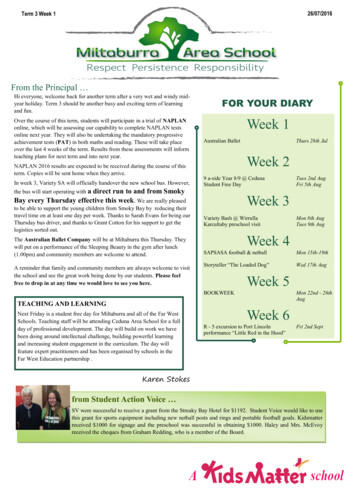
Transcription
Growing WordsWord Part InstructionArlington Public Schools
Growing WordsGrowing Words is an instructional resource for K -5 teachers. Extensive researchshows that understanding common prefixes and suffixes, and how they combine with basewords and roots will make students more effective readers, writers and spellers, while alsosignificantly expanding a student’s vocabulary. In this guide, the K – 3 componentfocuses on common prefixes and suffixes and how adding these word parts to base wordschanges the word’s meaning. In grades 4 and 5 more attention is given to affixes androots in order to increase word knowledge. Steps for introducing the word part as well asopportunities for practice are included in this resource.Growing Words Components: Research justification for teaching affixes and roots Important vocabulary related to teaching affixes and roots Steps for Introducing a Word Part Instructional Activities Scope and Sequence of Word Parts by Grade Level Poster to display the affix or root under study Student record sheet for grades 2- 5 Sample SOL Stems SOL aligned Warm ups or Quick ChecksInstructional pacing for the introduction of word parts for our students varies by gradelevel. Kindergarteners and first graders are introduced to new prefixes or suffixes eachquarter/9 weeks, while second grade students are introduced to affixes on a biweeklybasis. Students in grades 3-5 are introduced to word parts on a weekly basis.Teachers should include this component in their language arts and content areainstruction regularly with the whole class. Adding this component to your whole classinstructional routine should only take 5-10 minutes per day and may be connected toreading and writing lessons as appropriate.This resource is designed to supplement regular oral language, word study and vocabularyinstruction. Although students perform at different developmental spelling levels, allelementary students are ready to begin learning the meaning of word parts, though theymay not be ready to spell the complete words correctly.This Growing Words resource is recommended as an excellent tool for expandingstudent vocabularies and developing more effective readers, writers, and spellers. Wehope that you will find the resource flexible and helpful.Dr. Michelle PicardSupervisor, English Language Arts2
Special thanks to the Arlington Public School classroom and reading teachers, specialists,and administrators who have worked to develop this resource guide and to all of the staffmembers that bring the work alive for our students. Contributing authors include:Dr. Michelle Picard, Supervisor, English Language ArtsGayle Kelley, Division Reading Specialist, English Language ArtsAlison Meadows, Reading Specialist, Barcroft ElementaryCarole Ebert, Reading Specialist, Claremont ElementaryNatani Vaughn, Classroom Teacher, McKinley ElementaryJennifer Clark, Reading Specialist, Long Branch ElementaryKim Gomez, Reading Specialist, Oakridge ElementaryRebecca Kennedy, Reading Specialist, Oakridge ElementaryRosemary Giangiulio, Reading Specialist, Hoffman Boston Elementary3
Research Justification for Teaching Roots and AffixesA “Roots” Approach to Vocabulary: Insights from ResearchTim Rasinski, Nancy Padak, Rick M. Newton, Evangeline NewtonWhy Latin and Greek Roots?DID YOU KNOW?In Ancient Rome, school children studied out loud in class. As they learned new wordsthey would sound them out with their voices. This is why the English word vocabulary(meaning a “list of words”) is built on the Latin word for “voice.” Students took theirvocabulary quizzes by reciting the words aloud. Even as adults, Romans continued thehabit of reading everything out loud. Roman doctors would often order sick patients togive up reading for awhile because their reading would irritate their vocal cords andmake a sore throat worse! (“Building Vocabulary from Word Roots,” Level 4) Over 60% of the words students will encounter have recognizable word parts; many ofthem are derivatives of Latin and Greek roots (Nagy, Anderson, Schommer, Scott, &Stallman, 1989). School texts have a vast number of words from Latin andGreek roots. Latin and Greek prefixes, bases and suffixes have unique semantic features andconsistent orthographic patterns. Knowledge of these roots linkspronunciation, meaning and spelling, especially useful for youngreaders (Rasinski & Padak, 2001; Bear, Invernizzi, Templeton & Johnston, 2000). Content area vocabulary (e.g., mathematics, science, literature,technology) is largely of Greek and Latin origin. Research in content areavocabulary has demonstrated the effectiveness of teaching Greek and Latin wordroots, especially for struggling readers (Harmon, Hedrick & Wood, 2005). Many English language learners speak first languages semanticallyembedded in the Latin lexicon (e.g., Spanish). Enhancing this naturallinguistic connection can accelerate these students’ vocabulary growth (Blachowicz,Fisher, Ogle & Watts-Taffe, 2006). Many words from Greek and Latin roots meet the criteria of “tier two” words describedby Beck, McKeown, and Kucan (2002) as appropriate for instruction because they are“high frequency words for mature language users” (p. 16). Classroom-based studies have demonstrated the effectiveness of teachingword parts and context clues (Baumann, Font, Edwards, & Boland, 2005;National Reading Panel, 2000).4
An important goal of vocabulary instruction should be to help students becomeindependent word learners who use research-tested strategies to determine themeaning of new words. Vocabulary instruction should also develop “wordconsciousness,” an awareness of, interest in, and curiosity about words (Blachowicz &Fisher, 2006; Graves & Watts-Taffe, 2006). Research shows that the study of “roots” gives students the ability to learnmany new words independently by helping them make connectionsamong words and word families that are semantically related (Nagy &Scott, 2000). Activities that use “roots” for word exploration (etymology)and word play (puns, riddles) also foster “word consciousness” (Lehr,Osborn & Hiebert, 2004; Newton & Newton, 2005).“Research in vocabulary instruction has underscored the criticalimportance of students’ understanding how prefixes andsuffixes combine with base words and word roots to create newwords. This understanding can help students analyze unknownwords they encounter in their reading and leads to a richexpansion and elaboration of their vocabularies.” (Words TheirWay)5
Important Vocabularyaffixmost commonly a suffix or prefix attached to a base word, stem, or rootprefixan affix attached at the beginning of a base word or word rootsuffixan affix attached at the end of a base word or word rootbase worda word to which prefixes and/or suffixes are added. For example, the baseword of unwholesome is whole.rootswords parts, usually of Greek or Latin origin, that are often combined withother roots, prefixes and suffixes to form wordsmorphemethe smallest linguistic unit that carries meaning. For example,unbreakable has three morphemes (un, break, able).dedicate dictatedictiondictionary edict indictjurisdiction predicate predictvaledictorian verdict vindicatedic/dict“to speak”Excerpts from: Words Their Way: Word Study for Phonics, Spelling, and Vocabulary (Bear, Invernizzi,Templeton, and Johnston, 2011)6
Steps for Introducing a Word Part1Introduce the new word part (i.e. prefix, suffix, root). Give themeaning and a few sample words. Use visuals when appropriate.Today, we will look at the prefix “un”. The prefix un- usuallymeans “not.” It is usually used to mean a reversal or removalof some action or state; giving the opposite force. In theexample, untie the prefix means to not be tied or to remove orreverse the act of having shoes or sneakers tied.untie2 Ask students to brainstorm other words that have the same word part. Recordthese on a class chart.For example: un – means rap* Please note that often students will identify words with the same letters as theprefix under study such as “un” however the letters do not represent a prefix andtherefore do not influence the word’s meaning. In this example the words uncleand understanding both have the beginning syllable “un,” but they are not affixedto a base word and do not represent the meaning “not.” Be sure to call attention tothese instances as you introduce word parts.3 Underline the base word and circle prefix and/or suffix.4 Ask students in pairs to select two words and to share how the words are relatedIn this example, a student may suggest that untie and uncool both meanthat the item in not tied and not cool.5 Student practice: Choose one of the activities on the following pages for studentsto complete independently or in pairs. For example, each student will choose fourwords from the chart to draw and label in a vocabulary notebook.7
Instructional Activities K – 3Teaching prefixes and suffixes to K-1 students should be both explicit and integrated intodaily oral language, reading and writing activities. Students need to be taught themeaning of specific word parts and given multiple opportunities to interact with words. Awell-developed vocabulary is dependent on the richness and frequency of verbalinteractions. The prefixes and suffixes in this guide can easily be incorporated intolanguage arts and content area instruction. Use the provided poster or chart paper to display the prefix or suffix being introduced.This poster can be laminated and used with dry erase markers. Brainstorm words that have the specific prefix or suffix. Hunt for words that have the specific prefix or suffix. Record all words found on a master class list. Keep running posters of all word parts studied in a Living Bulletin Board. Allowstudents to add to the various charts as they find more words in their reading. Illustrate meaning of new words learned. Compare words with the word part being studied in which the part does and does notcarry the meaning. For example “un” means “not” in unacceptable, but does not carrythe same meaning in under or hunt. Create riddles for words. Create picture and/or word sorts to compare and contrast word meanings. Forexample singular/plural, past tense/present tense. Play Prefix or Suffix Jeopardy. Create, define and illustrate new words utilizing different words parts learned. Draw and label words with the same base word or affix. Integrate into daily routines such as Morning Message, class meetings, calendaractivities. Integrate into content area instruction.8
Instructional Activities Grades 4- 5 Use the poster to display the affix or root being studied each week. This poster can belaminated and used with dry erase markers. Brainstorm words that have the word part. Hunt for words that have the word part. Record all words found on a master class list. Keep running posters of all word parts studied in a Living Bulletin Board. Allowstudents to add to the various charts as they find more words in their reading. Illustrate meaning of new words learned. Compare words with the word part being studied in which the part does and does notcarry the meaning. For example “un” means “not” in unacceptable, but does not carrythe same meaning in under or hunt. Create riddles for words. Play Prefix, Suffix, or Word Root Jeopardy. Create, define and illustrate new words utilizing different words parts learned. Draw and label words with the same root or affix.9
Growing Words – Kindergarten1st QuarterWord Part-s-es2nd Quarter-ing-edrd3 , boxessuffixsuffixactionpast tensereading, talkingwalked, playedsuffixcomparativestronger, strongestprefixnotunhappy, untieprefixagainrewrite, reread4th QuarterunreReviewGrowing Words – First Grade1st QuarterWord Part-s-es-ing-ednd2 , boxessuffixsuffixactionpast tensereading, talkingwalked, playedsuffixcomparativestronger, strongestunrerd3 Quarter-ly-yprefixprefixnotagainunhappy, untierewrite, rereadsuffixsuffixquickly, loudlychewy, sticky-ful4th Quartersuffixresemblingforms adj. ordiminutivefull earful, careful10
Growing Words – 2nd Grade1st QuarterWeekWord Part1-2-edPartsuffixMeaningpast tenseExamplewalked3-4-ingsuffixactionsinging4-5-s, -essuffixpluralcats, y4-5-ysuffixchewy, sweaty6-7*in-prefixforms adj. ordiminutivenot8-9il-, *im-, ir-prefixnotimpossible, irregular,illegal-er/-orsuffixone whoteacher, sailor3-4-er/-estsuffixcomparativestronger, oreprecaution8-9sub-prefixunder, suffixfull offearful4-5-nesssuffixhappiness6-7non-prefixstate orquality ofnot8-9Review2nd Quarter1-23rd Quarter1-24th Quarter1-2inaccuratenonfiction11
Growing Words – 3rd Grade1st QuarterWeekWord -, il-,*im-, ir-edsuffixpast tenseinaccurate, impossible,irregular, emblingquickly8-s, -essuffixpluralcats, boxes9Reviewprefixinenclose, embed2nd Quarter1en-, em2non-prefixnotnonfiction3*in-, *im-prefixintoinhale, immerse4over-prefixtoo muchoverpriced5-er, -orsuffixone whoteacher, sailor6-ersuffixstronger, faster7-estsuffix8-ion, -tion,-ation, state orquality of9smartestsuspicion, caution,desperation, ignition,12
Growing Words – 3rd Grade3rd QuarterWeekWord prefixunder, efixinternational5-ible, -ablesuffixamong,betweenis ablecombustible, comfortable6-al, -ialsuffixrelating tomaternal, filial7-ysuffixchewy, sweaty8-nesssuffixforms adj. ordiminutivestate orquality of9Reviewforeseedeform4th Quarter1happinessfore-prefix2de-prefixin front,beforenot, versuperimpose5-ity, -tysuffixnecessity, loyalty6-mentsuffix7-icsuffix8-ous, -ioussuffixstate orquality ofproduct/thing,forms nounfrom verbrelating to,forms adj.full of, formsadj. and adv.9Reviewenjoyment, pavementhistoricjoyous, religious13
Growing Words – 4th Grade1st QuarterWeekWord -, il-,*im-, ir-lysuffixresemblinginaccurate, impossible,irregular, refixtoo littleundernourishedwooden, takennegative, talkative, positive2nd Quarter1under2-ensuffix3suffix4-ive, -ative, itivegraphrootmade of/formsadj., past actioninclined to,forms adj.write5finrootendfinale, confine, define6gramrootletter, writtentelegram, diagram7aud(i)roothearaudience, audible, audition8spec, spectrootsee, a kindspecial, species, aspect,inspect, spectacle9Reviewphotograph, autograph14
Growing Words – 4th Grade3rd QuarterWeekWord Part1terr2tractrootMeaningland, earth orfrightpull, drag3vocrootvoice or calling4rootmove5mob, mov,motportvocal, advocate,convocation, vocationmobile, motion, movementrootcarryportable, transport, import6vid, visrootsee7dic, dictroot8scrib, scriptrootproclaim,speak, saywritevideo, provide, vision,visiblededicate, dictate, predict,contradict, verdictscribe, scribble, inscription9Reviewroottime4th Quarter1chronPartroot2duc, mpleterritory, terrain, terrace,terror, terrible, deterredtractor, attract, subtractchronological, synchronize,chronicleinduce, produce, abduct,conduct, aqueductastronaut, astronomy,disasterautocracy, autobiography,autonomygeology, geometry,geographybiology, biography, biopsytransmit, submit, admit,permitphilosophy, philanthropist,philharmonic15
Growing Words – 5th Grade1st QuarterWeekWord -, il-,*im-, ir-lysuffixresemblinginaccurate, impossible,irregular, illegalquickly6sens, rootorder2nd Quarter1mand, disease,feelingwell6phonrootsound7omnirootall8jur, jusrootlaw9Reviewsensation, sense, sensitive,sensibletelescope, telephone,telegraphmanicure, manifest,manual, manufacturecommand, mandate,commend, recommendphotograph,photosynthesis, telephotolucent, lucid, lucite,elucidatepathology, sympathy,pathosbenefit, benediction,benevolentphonograph, symphony,telephoneomnipotent, omniscient,omnivorejury, injure, jury, conjure,perjury, justice, justify16
Growing Words – 5th Grade3rd QuarterWeekWord ootscience of4genroot5qui(t)rootbirth, begetor dorest, otsee7novrootnew8gradrootstep, go9Review4th Quarter1Exampleprologue, dialogue, eulogy,monologueanalogy, apology, logicpsychology, biology,anthropologygeneration, genocide,agent, exigenciesacquit, quite, requitevacant, vacation, vacuum,evacuate, vacuousaquarium, aquatic,aquamarine, aquiferhydroelectric, hydrogen,hydrantlegal, illegal, legitimate,illegitimatestructure, construct,instruct, destructioncredible, discredit,credentialfortitude, comfort, effort,fortifynatal, native, nation,nativity, innatemicroscope, telescope,periscopenovel, novelty, novice,innovategraduation, gradual, grade,centigrade17
Sample SOL StemsSOL 3.4b Use knowledge of roots, affixes, synonyms, and antonymsSOL 4.4b and 5.4c Use knowledge of roots, affixes, synonyms, antonyms, andhomophonesIn which word is –ly used the same as it is in (lone)ly? Sample sentence given; choiceslistedIn which words does un- mean the same as it does in un(happy)? Sample sentence given;choices listed -could be more than one answerSelect each word with a suffix that means “ .”Which word sounds like the word ?Choose the two words that sound the same but are spelled differently.Select the word with a root that means “ .”Which two words are antonyms for ?What does the suffix (-x) mean in the word ?In which word does the prefix (x-) have the same meaning as it does in the word ?18
Growing WordsWord PartprefixsuffixMeaning:Examples:19
Growing WordsWord Part of the Weekprefixrootsuffix20
Growing WordsWord Part of the WeekWord Part:Word Part:Word les:21
Other ResourcesWords Their Way: Word Study for Phonics, Vocabulary and Spelling Instruction byBear, Invernizzi, Templeton & JohnstonWords Their Way: Word Study with English Language Learners: Word Study forPhonics, Vocabulary and Spelling by Helman, Bear, Templeton, InvernizziWords Their Way For PreK-K by Johnston, Invernizzi, Helman, Bear, and TempletonVocabulary Their Way: Word Study with Middle and Secondary Students by Templeton,Johnston, Bear & InvernizziBringing Words to Life: Robust Vocabulary Instruction by Isabel L. Beck, Margaret G.McKeown, and Linda KucanGreek and Latin Roots: Keys to Building Vocabulary by Timothy Rasinski, Nancy Padak,Rick NewtonWord Journeys: Assessment-Guided Phonics, Spelling and Vocabulary by Kathy GanskeWord Sorts and More: Sound, Pattern, and Meaning Explorations K-3 by Kathy GanskeMindful of Words: Spelling and Vocabulary Explorations, 4-8 by Kathy GanskeHelpful WebsitesDictionary.comOnline Etymology DictionaryOne Look ://www.onelook.com/Please note that word lists with each of these word parts may be found in the resourceslisted above.22
6 Important Vocabulary affix most commonly a suffix or prefix attached to a base word, stem, or root prefix an affix attached at the beginning of a base word or word root suffix an affix attached at the end of a base word or word root base word a word to which prefixes and/or suffixes are added. For example, the base word of unwholesome is whole. roots words parts, usually of Greek or Latin .










